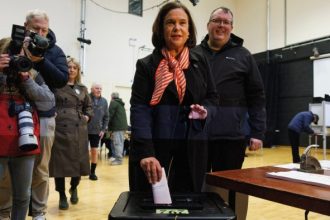Stay informed with free updates
Simply sign up to the Eurozone economy myFT Digest — delivered directly to your inbox.
The eurozone economy looks set for another downturn in the fourth quarter, while a recent pick-up in inflation is expected to persist in the coming months, the vice-president of the European Central Bank has warned.
In comments aimed at damping market expectations of an interest-rate cut in March, Luis de Guindos said in a speech in Madrid on Wednesday that the rapid pace of disinflation seen last year was likely to “slow down in 2024 and to pause temporarily at the beginning of the year”. Consumer price growth in the eurozone picked up from 2.4 per cent in November to 2.9 per cent in December.
He added that soft indicators pointed to an economic contraction in December. That would confirm “the possibility of a technical recession in the second half of 2023 and weak prospects for the near term”, he said.
His comments underline how the ECB faces an awkward decision when it meets on January 25 over how early to start cutting rates when the economic outlook is weak and inflation remains above its target of 2 per cent. While many economists predict eurozone inflation will hit that target this year, the central bank is not forecasting this until the third quarter of 2025.
The ECB’s cautious view on the pace of disinflation was underlined by its executive board member Isabel Schnabel, who wrote in a Q&A session on social media site X: “It is too early to discuss rate cuts.”
To be sure that inflation would return sustainably to the ECB’s target “requires additional data confirming the disinflationary process,” she said, adding: “Geopolitical tensions are one of the upside risks to inflation as they could drive up energy prices or freight costs. That’s why we need to remain vigilant.”
De Guindos did not say what a likely recession would mean for monetary policy — sticking to the ECB’s oft-repeated line that “future decisions will continue to follow a data-dependent approach to determining the appropriate level and duration of restriction”.

Carsten Brzeski, an economist at Dutch bank ING, said the central banker’s comments about inflation picking up reduced the likelihood of a rate cut by the ECB in the first quarter. “If you connect the dots, it is another argument against March rate cut expectations,” he said.
De Guindos said he expected inflation in the eurozone to follow a similar path to Spain, where it dropped below 2 per cent in June 2023 before rising above 3 per cent in the final four months of last year as the government phased out energy subsidies.
“Positive energy base effects will kick in and energy-related compensatory measures are set to expire, leading to a transitory pick-up in inflation,” he said.
The eurozone economy stagnated for much of last year and shrank 0.1 per cent in the three months to September from the previous quarter.
It is widely expected to stage a mild recovery this year thanks to lower inflation and higher wages. The ECB had forecast last month that eurozone growth would accelerate from 0.1 per cent in the fourth quarter of 2023 to 0.4 per cent in the third quarter of this year.
But De Guindos cast doubt on this by saying growth was “disappointing” and “the slowdown in activity appears to be broad-based, with construction and manufacturing being particularly affected”. He added: “Services are also set to soften in the coming months as a result of weaker activity in the rest of the economy.”
His gloomy outlook stems largely from a closely watched survey of eurozone purchasing managers that pointed to a continued decline of business activity at the end of last year. The S&P Global PMI index was revised up last week but that left it unchanged at 47.6, remaining well below the 50-mark that separates contraction from expansion.
De Guindos said the eurozone labour market “continues to be particularly resilient to the current slowdown” after unemployment in the bloc returned to a record low of 6.4 per cent in November.
Read the full article here




